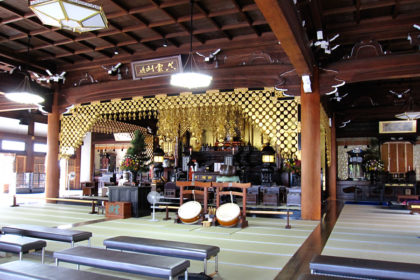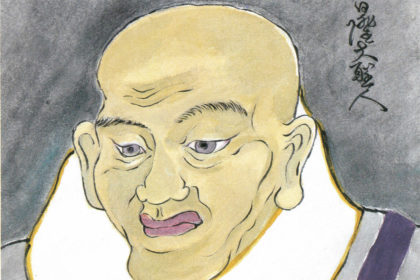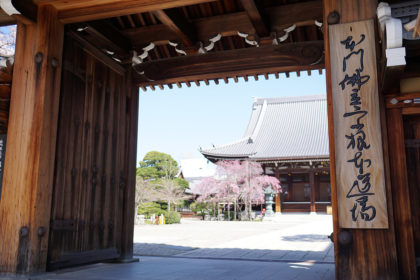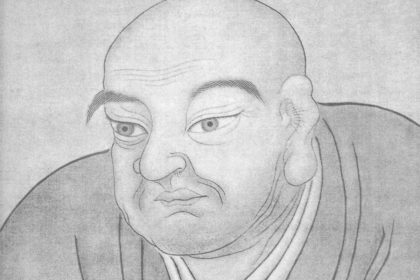
Nissen Shonin (Seifu Nagamatsu) was born into the OOJI, a merchant family in Muro-machi, Takoyakushi-dori, Kyoto city at the end of the EDO period, in 1817 (the fourteenth year of Bunka era). He was naturally talented in art and literature, and at his age of nine, his name was in the part of calligraphers and painters on Heian Jinbutsushi, a directory of well-known people in Kyoto of the Edo period. At the young age before 30, he traveled to Edo to study under Kodo MATSUZAKI, Confucian scholar, and attained greatness as a waka poet and a calligrapher in the townsman class. Nissen Shonin’s future should have been promising as a major calligrapher or scholar of Japanese classical literature, but he began to get into Buddhism and study various Buddhist doctrines through the experiences of his mother’s death and his own severe illness. When he was invited to perform his painting and calligraphy at Honnoji temple (the temple Nichiryu Shonin founded), he has encountered Honmon Happon teachings of the Lotus Sutra and found the faith in the Odaimoku, Namu-myohorengekyo.
Buddhist society of those days in Japan lapsed into idleness and was spending all the time engaging Soshiki-Bukkyo* since Danka system (all the common people had to belong to bodaiji—family temple and become the temple’s danka—supporter of a Buddhist temple) had been established by the bakufu (Japanese feudal government headed by a shogun) as a part of its policy for religions to suppress Christians. To recover the original purpose of Buddhism—religion for living persons, Nissen Shonin entered into the priesthood at Ryusenji temple of the Hokke sect in Awaji island, Hyogo prefecture, at his age of thirty-two. However, since his enthusiasm for a reform of Japanese Buddhism and salvation of common people wasn’t a help, rather a hindrance to not only Hokke sect but also the whole Buddhist society that lapsed into idleness, they began to suppress Nissen Shonin harshly. Even so, he founded a new Buddhist sect, Honmon Butsuryu Ko on January 12, 1857 (the twelfth of the first month of the fourth year of Ansei period) with great pride that he was the only person who inherited the legitimacy of Nichiren and Nichiryu Shonin, messengers of the Primordial Buddha. It was at his age of forty. Honmon in Honmon Butsuryu Ko is literally means “Honmon Happon teaching,” Butsuryu means “the Buddhist sect that not a man who was said to be a Buddhist master but the Primordial Buddha established,” and Ko represents “a group of priests and lay followers who study Buddhist scriptures.” Therefore, Nissen Shonin established a sect that believes in and rely on the Odaimoku—quintessence of Honmon Happon teaching of the Lotus Sutra in accordance with the true intention of the Primordial Buddha.
From that time on, Nissen Shonin spread Nichiren Shonin’s teachings through Gokyoka, 3,000 or more tankas (31 syllables’ poem) that Nissen Shonin himself composed to make Nichiren doctrines easier to understand in the ages when there were many people who cannot read or write. Honmon Butsuryu Ko became a force mainly in the Kyoto-Kobe-Osaka area as Nissen Shonin showed Gensho no Goriyaku everywhere by thorough practice of Kusho-gyo (see What will happen if we chant the Odaimoku, Namu-Myohorengekyo?) until he died at 74 on July 17, 1890 (the 23rd year of Meiji era).
HBS members call Nissen Shonin also Kaido Shonin. Kaido is an abbreviation for “Kaihotsu-kyodo.” Kaihotsu literally means “bringing waste land under cultivation” and Kyodo means “teaching and guiding.” Therefore, the title Kaido expresses that Nissen Shoninrevived the faith in the Odaimoku—quintessence of the teachings of the Primordial Buddha establishing a new Buddhist sect, Honmon Butsuryu Ko when it was just about to die out after about 430 years having passed since Nichiryu Shonin’s death and guided our feet into the way of true Buddhism.
(*) Soshiki-Bukkyo
Soshiki-Bukkyo (literally, ‘funeral Buddhism’) refers to a way of belief in which people conduct Buddhist funerals and Buddhist memorial services while being rarely involved in Buddhist activities and in Buddhist doctrines in their daily lives. The major turning point for Buddhism of Japan to change into Soshiki-Bukkyo was the Danka system. Due to the system, most of Buddhist sects in Japan forgot what Buddhist teachings are originally for or what the purpose of their existence is.





